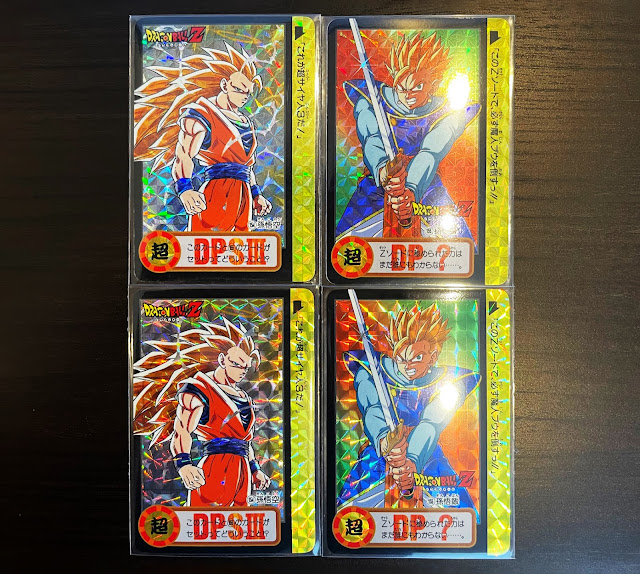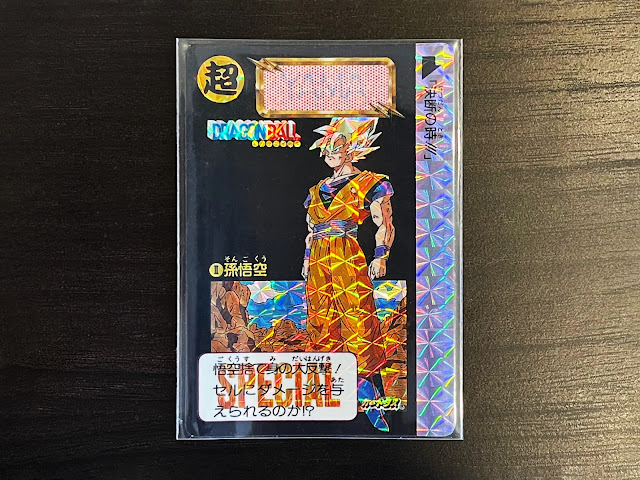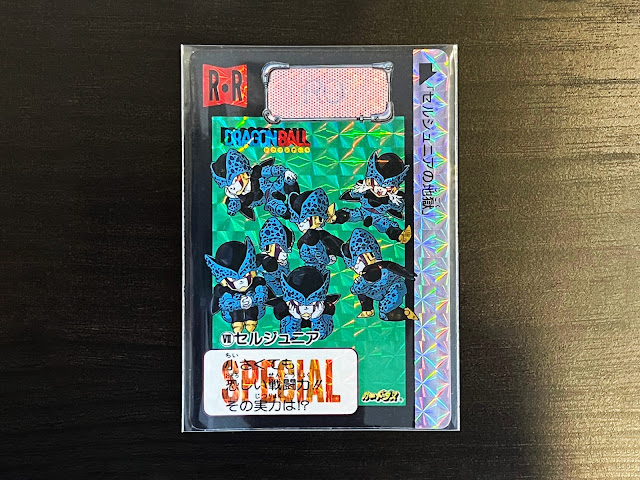This is an extension to the Toriyama Mechanko Project Carddass review, please first read the article here.
The Toriyama Akira Mechanko Project (
鳥山明めちゃんこプロジェクト in
Japanese) Shijou Battle (誌上バトル) questionnaire of 1993 was introduced in the pages of Jump. Thankfully there is a blog that kindly
shared all 50 questions as they were originally published. Thanks to the writer of that blog called りょう (Ryo) for making these easily accessible.
Part 1 questions 1~10
Part 2 questions 11~20
Part 3 questions 21~30
Part 4 questions 31~40
Part 5 questions 41~50
Here is a nearly complete translation of all 50 questions and answers from the questionnaire:
- (1) What was the password to call Shenron on Planet Namek?
1. Pepporunga hattaripito horopuruppipe
2. Takkaraputo poppurunga pupirittobaro
3. Bametopiran tererorukoro popporunga
4. Boropparabi tanomoreruro pereparorunga
5. Rapputotaka rupporunga ripputopiparo
- (2) During the 23rd Tenkaichi Budoukai who were the participants of the second match?
1. Goku & Chichi
2. Jackie Chun & Man-Wolf
3. Krillin & Piccolo
4. Tenshinhan & Goku
5. Yamcha & Shen
- (3) The picture below of Android 16 was published in the comics. What is the character hidden in the mark of the Mechanko Project?
1. 16
2. CAPSULE CORP.
3. RR
4. DR GERO
5. RED RIBON
- (4) What was the TV department of channel 827 doing live broadcast in Ginger Town?
1. ZTV
2. CHQ
3. DQZ
4. UFW
5. CQV
- (5) Who is the character who was killed at the beginning of the title story in the color issue titled "NEW YEAR Super Power Battle"?
1. Krillin
2. Chaozu
3. Dende
4. Jeece
5. Freeza
- (6) In the Dragon Ball Power Up calender of 1993, in the months of April, May, and June which of these boots was Gohan wearing?
1. Jungle boots
2. Ring boots
3. Side gore boots
4. Engineer boots
5. Short boots
- (7) In the comics between volumes 1~33, after Goku which character makes the most appearances in the opening pages?
1. Gohan
2. Krillin
3. Piccolo
4. Vegeta
5. Kamesennin (Master Roshi)
- (8) After Goku defeated Piccolo Daimaoh, what was the channel Bulma informed from the radio on the plane?
1. NWA
2. CNN
3. NBS
4. BMW
5. BPS
- (9) In the comics 1~33 there was a thing that had "43" written in it. What was it?
1. Broadcasting station's camera
2. Goku's jacket
3. The hovercar Gyuumaou was riding
4. A car Goku was riding
5. A car Satan was riding
- (10) The picture below is an enlarged view of a town next to a city. Where is this located?
1. North City, northwest 9 km
2. West City, southeast 9 km
3. East City, northeast 9 km
4. South City, southwest 9 km
5. Midle Town, north 9 km
- (11) According to the information from the news reporter, how many humans would Cell have absorbed, excluding the androids?
1. 500 people
2. 1000 people
3. 1500 people
4. 10,000 people
5. 15,000 people
- (12) Which of the following is the name of the town near the hospital where Goku was hospitalized when heavily injured?
1. Wild Denshaa
2. Hill Town
3. Downtown
4. Ginger Town
5. Apple Town
- (13) Which of the following manga books did Bulma bring with her to planet Namek?
1. Dragon Ball
2. Dr Slump
3. Kosuke & Rikimaru
4. Mad Matic
5. Pink
- (14) In the comics between volumes 1~33, after Goku which character makes the most appearances in the table of contents title pages?
1. Gohan
2. Piccolo
3. Bulma
4. Vegeta
5. Freeza
- (15) During one of Kamesennin training days Goku and Krillin delivered milk. how many empty bottles did they collect together in one day?
1. 6 bottles
2. 8 bottles
3. 10 bottles
4. 12 bottles
5. 16 bottles
- (16) In the 1990 Miracle Card Jump calendar there were a card for each number. What was the 0 card mark?
1. Heart
2. Diamond
3. Spade
4. Clover
5. Joker
- (17) What chapter and what title was the illustration on the right used for?
1. One hundred, unprecedented fear
2. One hundrer, unprecedented threat
3. Two hundred, unprecedented fear
4. Two hundred, unprecedented shock
5. Three hundred, unprecedented shock
- (18) The Arc Demon from DQ (Dragon Quest) has a cameo in which of the following parts?
1. Red Ribbon Army HQ
2. West City
3. Penguin Village
4. Tenkaichi Budoukai preliminary grounds
5. Inside Muscle Tower
- (19) In the 1990 Jump Calendar what month to what month was the Dragon Ball illustration?
1. July to August
2. August to September
3. September fo October
4. July to September
5. August to October
- (20) When Goku had Bulma repair the Dragon Radar in her house, approximately what time was it?
1. 9:00
2. 10:00
3. 11:00
4. 12:00
5. 13:00
- (21) Which among these characters was carried on the box written "TEA FOODS"?
1. Small fry character n79 from Planet Freeza
2. Gohan
3. Krillin
4. Trunks
5. Gyuumaou (Ox King)
- (22) The great decisive battle between Goku and Piccolo Daimao unfolded at King Castle. How many total episodes were spent on this head-to-head?
1. 5 episodes
2. 6 episodes
3. 7 episodes
4. 8 episodes
5. 9 episodes
- (23) * At the moment unable to decipher this question based on quality of the current image below.
1. 123
2. 125
3. 127
4. 129
5. 131
- (24) Who is Goku's opponent in the episode with the color subheading "Final Decisive Battle Intro"?
1. Piccolo Daimaoh
2. Ma Junior
3. Vegeta
4. Freeza
5. Cell
- (25) For chapter 354 "Surplus of the Androids" there was a figure present(?). What day and month was the deadline?
1. 1992, January 6
2. 1992, January 7
3. 1992, January 8
4. 1992, January 9
5. 1992, February 8
- (26) What is Bulma's identification number?
1. SKM11875
2. SSC41453
3. SSK14875
4. SKC41875
5. SCS14534
- (27) Between comic volumes 1~33 which of the following characters has never worn a hat?
1. Krillin
2. Gohan
3. Chichi
4. Tenshinhan
5. Yamcha
- (28) How many of Mutaito's disciplines appear in the original manga work?
1. 3 people
2. 4 people
3. 5 people
4. 6 people
5. 7 people
- (29) In what year and in which issue was the chapter 130 published in Jump?
1. Showa 62, issue 30
2. Showa 62, issue 31
3. Showa 62, issue 32
4. Showa 62, issue 33
5. Showa 62, issue 34
- (30) Which of these is the original name of Frypan Yama (Mount Frypan)?
1. Ryoukeizan
2. Fuurinkazan
3. Koppepan Yama
4. Gyuumaou Yama
5. Kakazan
- (31) How many buildings are there on the Capsule Corporation premises?
1. 2
2. 4
3. 6
4. 8
5. 10
- (32) Why is there no hair on Krillin's head? Which of the following is the explanation?
1. He shaved it to be able to use the Taiyouken
2. He was born with no hair
3. His hair fell out during martial arts training
4. He shaved his hair to tighten his Ki
5. In the original work an explanation is not provided, so it is unknown
- (33) Which of the following characters had a kettle in Kame House?
1. Kamesennin
2. Lunch
3. Krillin
4. Bulma
5. Chichi
- (34) What is the game software found on the desk of Dr. Brief?
1. Super Mario Brothers
2. Dragon Ball Z
3. Dragon Quest
4. Donkey Kong
5. The Legend of Zelda
- (35) Of the following character names in the Red Ribbon Army, which does not exist in the original work?
1. Brown
2. Violet
3. Yellow
4. Kappa
5. Grey
- (36) How many Namekians did Frieza kill himself?
1. 0 people in total
2. 1 person in total
3. 2 people in total
4. 3 people in total
5. 4 people in total
- (37) In Jackie Chun's (Kamesennin) deathblow what character appears in the page from the illustration below?
1. 万國突天掌 (Bankoku Bikkuri Shō)
2. 万國吃天掌 (Bankoku Bikkuri Shō)
3. 万國尾天掌 (Bankoku Bikkuri Shō)
4. 萬國仰天掌 (Bankoku Bikkuri Shō)
5. 萬國驚天掌 (Bankoku Bikkuri Shō)
- (38) Approximately how long from that world was the serpent road to reach Kaiou sama?
1. 10,000 km
2. 100,000 km
3. 1,000,000 km
4. 10,000,000 km
5. 100,000,000 km
- (39) What does the following Namek language symbol represent (refer to picture below)?
1. Complete
2. Roger
3. God
4. No way
5. Be silent
 |
How good is your understanding of Namekian language?
|
- (40) Which of the following was the hour at which Vegeta and Nappa arrived on earth?
1. 11:34
2. 11:43
3. 23:34
4. 23:43
5. Time undetermined
- (41) Excluding himself, how many people knew of Jackie Chun's true identity?
1. 1 person
2. 2 people
3. 3 people
4. 4 people
5. 5 people
- (42) During the fight against Raditz, what was the gap between Piccolo's lowest and highest fighting power (power levels)?
1. 602
2. 690
3. 998
4. 1003
5. 1018
- (43) Which of the following company names did not appear in the comics?
1. LUCKY FOODS COMPANY
2. AIR PANIC
3. MATODOG CORPORATION
4. SOMY
5.BEANS CORP.
- (44) Aside from himself, how many people knew that Shen's body had been borrowed by Kami?
1. 2 people in total
2. 3 people in total
3. 5 people in total
4. 6 people in total
5. 7 people in total
- (45) What is the name of the dragon Toriyama sensei drew on Koyami Mami's album jacket (voice of Lunch)?
1. Gebura
2. Kururu
3. Purin
4. Kurira
5. Hiyako
- (46) What is the title of the anime movie where Toriyama sensei appeared in one scene along with artist Takemiya Keiko?
1. Galaxy Express 999
2. Crusher Joe
3. Mobile Suit Gundam
4. Dr. Slump Hoyoyo Space Adventure
5. Space Battleship Yamato
- (47) When Toriyama sensei was little, he threw the O-Jizo's head into a soil reservoir and was scolded by his grandfather. He picked it up from the reservoir, washed it properly, and put it back together, but he had to suffer for a week. What was it that made him suffer?
1. He was crying in his dreams
2. He couldn't get rid of the smell of the reservoir
3. He got hit bumps
4. When he was walking around he spotted a headless Jizou
5. He kept falling into the reservoir
* O-jizo san are little buddhist statues
- (48) Which of Toriyama's works won the silver prize in the 9th Tamiya model modification contest?
1. Raiders
2. Dragon Ball
3. Nausicaa
4. Godzilla
5. Dr. Slump
- (49) Where is Capsule Corporation located
1. 29 West city
2. 29 East City
3. 43 West City
4. 43 East City
5. 23 West City
- (50) In the illustration below Goku received damage from a poweful enemy. From which fight was this?
1. Raditz fight
2. Vegeta fight
3. Freeza fight
4. Ginyu fight
5.Android 19 fight
As you can see the difficulty varied a lot. Fans would need to refer
back to the original manga work among other things while filling this out. As the
questionnaire was long, it probably wasn't easy to earn a high score!
Below is what the return form looked like. It had to be filed out with the
participants name, address, telephone number, and of course all or as
many of the answers filled out as possible.
 |
The entire multiple choice sheet that was to be returned completed
|
Hopefully you enjoyed, or at least found this page of interest, and hopefully it has given you better insight and appreciation for the very special contest that was the Toriyama Akira Mechanko Project challenge!
To return to the Toriyama Akira Mechanko Project Carddass set review click here.
Back to main index





















































